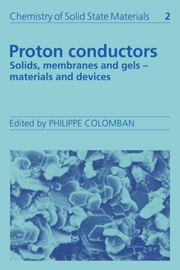Book contents
- Frontmatter
- Contents
- List of contributors
- Preface
- Symbols
- I HYDROGEN BOND AND PROTONIC SPECIES
- II MATERIALS: PREPARATION, STRUCTURES AND PROPERTIES
- III PROTON DYNAMICS AND CHARGE TRANSPORT
- 21 Incoherent neutron scattering studies of proton conductors: from the anhydrous solid state to aqueous solutions
- 22 NMR studies of local motions in fast protonic conductors
- 23 Vibrational spectroscopy of proton conductors
- 24 Raman spectroscopic studies of proton conductors
- 25 Frequency dependent conductivity, microwave dielectric relaxation and proton dynamics
- 26 Measuring the true proton conductivity
- 27 D.c. techniques and a.c./d.c. combination techniques
- 28 NMR in gels and porous media
- IV PROTON DIFFUSION MECHANISMS
- V DEVICES
- Index
23 - Vibrational spectroscopy of proton conductors
Published online by Cambridge University Press: 04 May 2010
- Frontmatter
- Contents
- List of contributors
- Preface
- Symbols
- I HYDROGEN BOND AND PROTONIC SPECIES
- II MATERIALS: PREPARATION, STRUCTURES AND PROPERTIES
- III PROTON DYNAMICS AND CHARGE TRANSPORT
- 21 Incoherent neutron scattering studies of proton conductors: from the anhydrous solid state to aqueous solutions
- 22 NMR studies of local motions in fast protonic conductors
- 23 Vibrational spectroscopy of proton conductors
- 24 Raman spectroscopic studies of proton conductors
- 25 Frequency dependent conductivity, microwave dielectric relaxation and proton dynamics
- 26 Measuring the true proton conductivity
- 27 D.c. techniques and a.c./d.c. combination techniques
- 28 NMR in gels and porous media
- IV PROTON DIFFUSION MECHANISMS
- V DEVICES
- Index
Summary
Introduction
Vibrational (infrared, Raman and neutron) spectroscopy can give useful information about proton conductors, i.e. about structural as well as dynamical aspects. Infrared spectroscopy appears particularly suited for such studies since AH stretching modes (A = O, N, halogen) give rise to strong absorption bands in a region (4000-1700 cm–1) where there is not much interference from other groups. Various protonic species can thus be studied, even at very low concentrations.
As far as crystalline structures are concerned, X-ray and/or neutron diffraction methods and vibrational spectroscopy are complementary. The former can determine with accuracy the structure of the rigid framework but have some difficulties in locating protonic species, particularly if they are (statically or dynamically) disordered and if their concentration is low. The latter are well-suited for the identification of protonic entities and their types of association, the investigation of some structural details such as different crystallographic sites, (non)equivalent molecules, protonation sites, A–H and A … B distances and the nature and degree of structural disorder.
Spectroscopic data can also be used to study dynamical aspects, either as proton dynamics deciphered from the AH stretching band profile or as the dynamics of phase transitions. They are helpful in determining the order (first or second), the nature (displacive, order-disorder, reconstructive) and particularly the mechanism of the transformation at the molecular level. This can also shed some light on the conductivity mechanism, which can change considerably in going from one phase to the other.
- Type
- Chapter
- Information
- Proton ConductorsSolids, Membranes and Gels - Materials and Devices, pp. 367 - 376Publisher: Cambridge University PressPrint publication year: 1992
- 4
- Cited by



